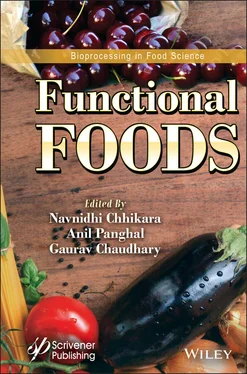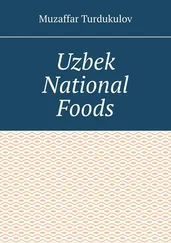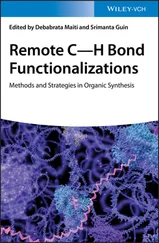Functional Foods
Здесь есть возможность читать онлайн «Functional Foods» — ознакомительный отрывок электронной книги совершенно бесплатно, а после прочтения отрывка купить полную версию. В некоторых случаях можно слушать аудио, скачать через торрент в формате fb2 и присутствует краткое содержание. Жанр: unrecognised, на английском языке. Описание произведения, (предисловие) а так же отзывы посетителей доступны на портале библиотеки ЛибКат.
- Название:Functional Foods
- Автор:
- Жанр:
- Год:неизвестен
- ISBN:нет данных
- Рейтинг книги:3 / 5. Голосов: 1
-
Избранное:Добавить в избранное
- Отзывы:
-
Ваша оценка:
- 60
- 1
- 2
- 3
- 4
- 5
Functional Foods: краткое содержание, описание и аннотация
Предлагаем к чтению аннотацию, описание, краткое содержание или предисловие (зависит от того, что написал сам автор книги «Functional Foods»). Если вы не нашли необходимую информацию о книге — напишите в комментариях, мы постараемся отыскать её.
Presenting cutting-edge information on new and emerging food engineering processes,
, the second volume in the groundbreaking new series, “Bioprocessing in Food Science,” is an essential reference on the modeling, quality, safety, and technologies associated with food processing operations today.
This outstanding new volume:
Audience: Functional Foods
Functional Foods — читать онлайн ознакомительный отрывок
Ниже представлен текст книги, разбитый по страницам. Система сохранения места последней прочитанной страницы, позволяет с удобством читать онлайн бесплатно книгу «Functional Foods», без необходимости каждый раз заново искать на чём Вы остановились. Поставьте закладку, и сможете в любой момент перейти на страницу, на которой закончили чтение.
Интервал:
Закладка:
3.2.2 Buckwheat
Fagopyrum esculentum Möench, commonly called buckwheat, is a traditional agricultural product historically grown in Asia and Central and East Europe [50]. It belongs to the family Polygonaceae, unlike most other cereals [51, 52]. However, buckwheat seeds can be classified as a cereal due to their chemical and usage properties, similar to cereal grains [53]. It is also known as a pseudocereal because of its differences from cereals [50, 53, 54]. The fundamental difference in terms of its structure is that buckwheat is dicotyledonous, as opposed to monocotyledonous species of cereal. The buckwheat seed’s embryo is found within the endosperm’s center, having two cotyledons. The embryo, endosperm, and seed coat are tightly surrounded by the hull (also known as the pericarp), which is hard and fibrous. Meanwhile, the walls of the cells that form the endosperm are quite thin [50, 55, 56].
Although numerous species of buckwheat are harvested globally, only 9 of them possess value for agricultural purposes [57–59]. There are varieties of buckwheat that can be harvested in summer, in autumn, and in the middle of the two seasons [53]. In general, two species are utilized globally: that known as common buckwheat ( F. esculentum) and that known as Tartary buckwheat ( F. tataricum) . While the former is grown in more widely spread and diverse environments, the latter is farmed in mountainous areas [57–59]. Buckwheat seeds are triangular and have blackcolored hulls that cover the kernels, with the kernels ranging in color from white to light shades of green. Color saturation opens towards the kernel’s innermost layers. The density of the hull is lower than that of water; therefore, hulls can be removed more easily from kernels [57, 59]. Hull hardness varies among different species. F. esculentum is generally less hard than F. tataricum . F. esculentum has a harsher flavor, while F. tataricum is slightly bitter. The bitter compounds in F. tataricum seeds can be extracted by assorted techniques, such as various chemical methods and isoelectric precipitation [57, 60].
Buckwheat contains relatively high amounts of dietary fiber, protein, some types of vitamins, and some types of minerals in comparison to other types of wheat or rice [53]. Protein levels of buckwheat range from 12% to 18.9% [61, 62]. The proteins found in buckwheat possess well-balanced amino acids and generally have high biological value [47, 61]. Buckwheat flour has lower ratios of glutelin and prolamin but higher ratios of globulin and albumin [53, 63, 64]. Gluten content is either very little or nonexistent [53, 65]. Thus, buckwheat plays an important dietary role as a gluten-free option that is suitable for people afflicted with celiac disease [53]. Starch levels are in the range of 59%–70% while lipid levels range from 1.5% to 4%. More than 40% of the 80% unsaturated fatty acids in its structure are polyunsaturated fatty acids (PUFA) [47, 59]. Multiple studies have reported that buckwheat’s total polyphenol content is 6.8–20.7 mg GA/g, while free polyphenol content is 4.5–17.1 mg GA/g, insoluble dietary fiber content is 2.3%–8.6%, soluble dietary fiber content is 1.4%–3.4%, and finally, total dietary fiber content is 3.6%–10.6% [62, 66]. Buckwheat is also a valuable resource for including macroelements such as Na, K, Mg, and Ca [47, 67] and microelements as Se, Zn, Mn, and Cu into the human diet [47, 68]. It is a grain rich in vitamins B 1and B 2[69, 70]. The significant contents and potential antioxidant activities of rutin and other polyphenols are very important for the dietary value of buckwheat [47, 69, 71]. In its grains and hulls, 6 flavonoids have been identified, including rutin, quercetin, orientin, vitexin, isoorientin, and isovitexin. On the other hand, only rutin and isovitexin have been determined in buckwheat seeds [51, 59, 72].
The consumption of buckwheat and buckwheat products is associated with many healthy biological activities including antidiabetic, anticancer, hypocholesterolemic, anti-inflammatory, neuroprotective, and hypotensive effect. Buckwheat proteins and polyphenols are supposed to be responsible for these effects [73, 74]. It has been accepted that some of the effects mentioned can be related to these two compounds in buckwheat. However, recently identified action mechanisms may also be exerting the health-promoting benefits that have been observed in cases of buckwheat consumption [74–76].
3.2.3 Oat
Oat is a cereal that has multifunctional uses including human food, animal feed, and health effects [77, 78]. The production of oat is in 6th place among grains worldwide, respectively following maize, wheat, barley, sorghum, and millet [79]. The world’s oat cultivation area is significantly smaller than that of some of these other grains [77 ,78], related to lower oat yields in comparison to other cereal yields [78, 80]. Oat accounts for >2% of the total global cereal production [79]. Oats are resistant to damp weather conditions and acidic soil. They are also generally disease-resistant. Also, they require less agricultural chemicals and fertilizer input [78, 81]. The production costs of oats can be similar to barley or wheat [78]. Nowadays, the main oat producers are Russia, Canada, the United States, and Northern Europe [82]. Global oat production is slightly more than 25 million tons per year [79]. According to the oat taxonomy given by Youngs et al ., oat species are categorized as diploid, tetraploid, and hexaploid oats [82, 83]. The majority of oats being grown these days are members of the hexaploid group of species. Avena sativa L., more popularly known as common white oat, is this group’s most widely utilized species. It is raised and harvested in the world’s temperate areas. Avena nuda (naked oat) provides groats, the hulls of which are removed in threshing. Due to their excellent grain quality, naked oats are desirable among producers and in various industries, and especially for specialty markets. However, this species has low yields and it is susceptible to both mechanical damage and mold [82, 84]. Avena byzantina , or the common red oat, is commonly harvested in the winter season in the south of the United States. Today, the majority of the varieties of oat that are being grown have come about as crosses of Avena sativa with Avena byzantina [82].
The oat grain comprises the groat, which in turn is enclosed within the external hull layer [79, 85]. Although structural differences between assorted varieties of oats have been highlighted by various researchers, generally speaking, an oat grain has a shell (25%); the pericarp, testa, and aleurone (9%); the endosperm (63%), which is a starchy substance; and the embryo (3%) [86]. Hulls must be separated from the groats before the beginning of the processing [85, 87]. After being dehulled, these grains or groats constitute approximately 75% of the whole grain’s total; this figure fluctuates between 65% and 80% due to both diversity and environmental differences [86]. Oat is generally consumed whole as oat flakes [85]. The metabolizable energy content of whole oats is 2.5 to 2.6 kcal/g, and it is quite low [88]. The highly nutritious nature of oat species means that they are beneficial components of human and animal diets [78]. The typical protein value of whole oats is 10%–12% [86, 89] and this value is similar to that of wheat [86]. Meanwhile, oats have amino acid contents that are better than those found in other grain species due to the main protein being globulin [78, 90]. Compared to prolamins, which are grain storage proteins, globulins contain higher amounts of lysine and other essential amino acids [78, 91]. Oats also contain high levels of lipids [78, 84, 92, 93]. The lipid concentration of oat groats is 2 to 5 times higher than that present in wheat. Lipid contents can reach amounts of up to 10% of the total oat mass [93,94]. The major fatty acids in oatmeal can be listed as linoleic acid (38%), oleic acid (36%), and palmitic acid (19%), followed by linolenic acid (2%) and stearic acid (2%). The water content of oatmeal is 8.5% and the ash content is 1.8%. About 57.8% of oatmeal consists of carbohydrates, so it can be said to be a valuable source for obtaining dietary fiber [79]. Total sugar contents of oats are about 1%, while reducing sugar contents are less than 0.1% [86, 95]. Meanwhile, there are rising levels of interest in the consumption of oat-derived food items due to the requirement for soluble fibers in the human diet, and especially β-glucans, having valuable health-promoting effects [78, 96–98]. 1,3- and 1,4-β-Glucans are present as 2% to 6% of the total mass of groats and 7% of the starchy endosperm [86, 99, 100]. β-Glucans create viscous gums with water [86, 101] and contribute to water retention capacity, processing behavior, and viscosity [86, 102]. As the most highly abundant component of oats, starch accounts for 60% of whole oat grain’s dry matter. Oat starch’s iodine affinity is about 19.5%. This is reasonably close to the values of wheat, rye, and barley [86, 103]. Also, the α-tocopherol content of oat grain is 4.5–12.3 mg/kg and can be considered as high [104].
Читать дальшеИнтервал:
Закладка:
Похожие книги на «Functional Foods»
Представляем Вашему вниманию похожие книги на «Functional Foods» списком для выбора. Мы отобрали схожую по названию и смыслу литературу в надежде предоставить читателям больше вариантов отыскать новые, интересные, ещё непрочитанные произведения.
Обсуждение, отзывы о книге «Functional Foods» и просто собственные мнения читателей. Оставьте ваши комментарии, напишите, что Вы думаете о произведении, его смысле или главных героях. Укажите что конкретно понравилось, а что нет, и почему Вы так считаете.










